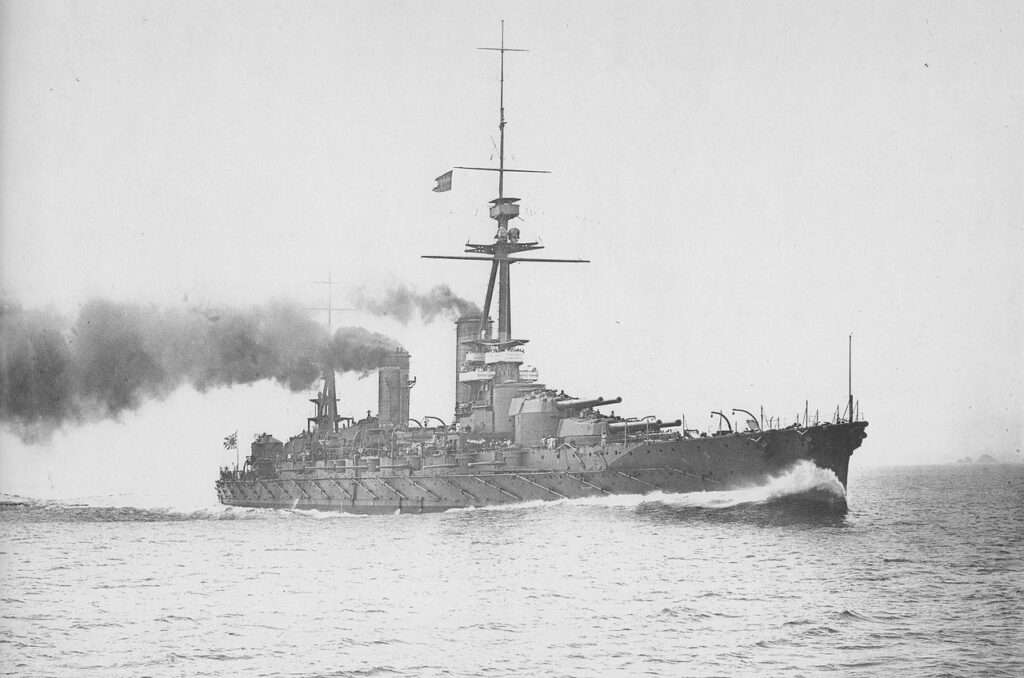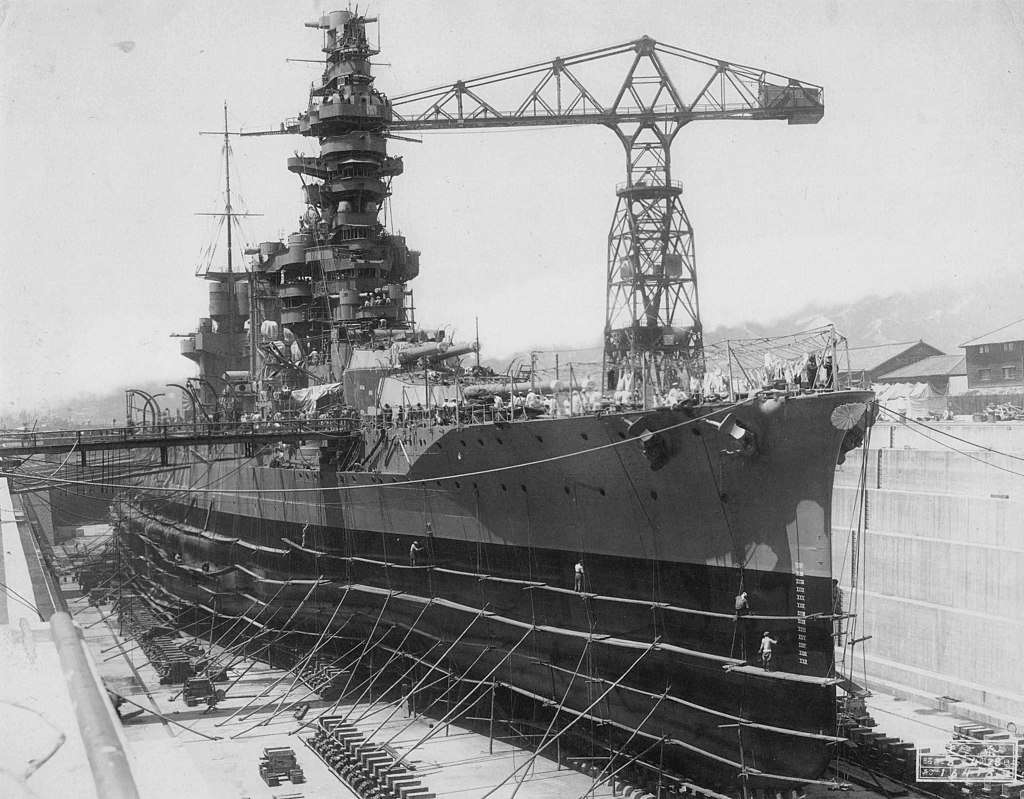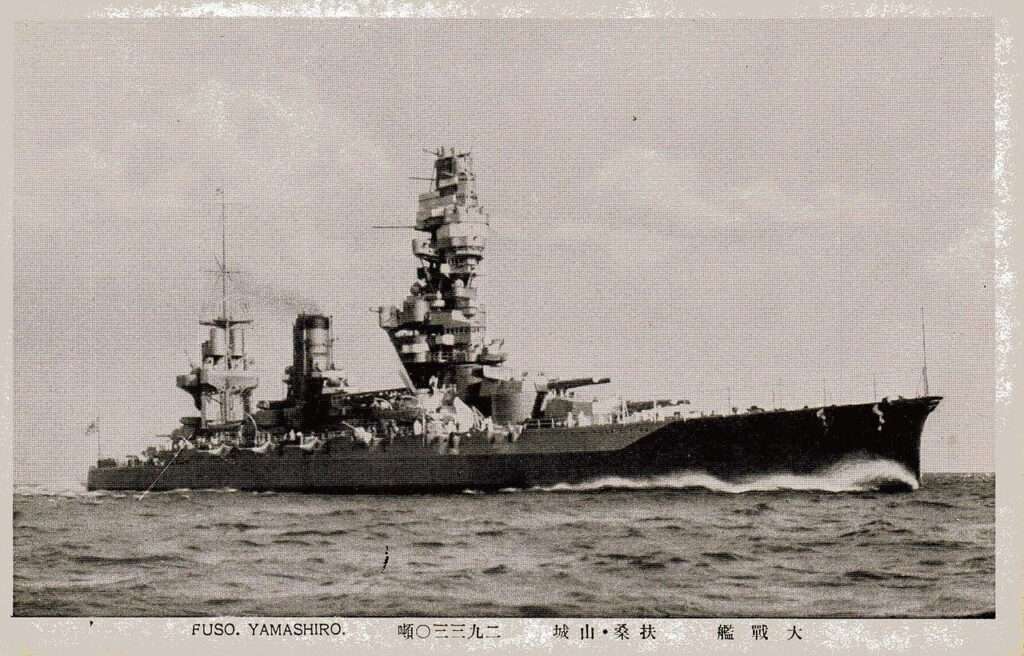The Japanese battleship Fusō, renowned for its imposing figure and formidable weaponry, bears a distinctive look that sets it apart from other warships of its era.
Its unique “pagoda mast” superstructure, laden with platforms and lookout posts, imparts a strange and somewhat exotic appearance, a testament to Japanese naval architectural style during the World War II period.
Despite this unusual aesthetic, the Fusō’s complex design contributed to its status as a symbol of Japan’s naval power and a crucial asset in its maritime warfare strategy.
Design
The Fusō, named after a historical province in Japan, was a monumental undertaking that began at the Kure Naval Arsenal, one of the most sophisticated shipyards in Japan during the early 20th century.
The keel-laying in March 1912 marked the beginning of a construction period that spanned over three years.
The Fusō’s design was a response to the naval arms race that characterized the early 20th century. As the lead ship of the Fusō-class, she was envisioned as a significant force multiplier for the Imperial Japanese Navy, specifically designed to outperform the latest battleships of potential adversaries.
Measuring 202.7 meters in length with a beam of 30.8 meters and a draft of 9.7 meters, the Fusō cut a majestic figure in the waters.
She displaced approximately 39,154 long tons at full load. Her propulsion system consisted of 24 coal-fired Miyabara water-tube boilers and four steam turbines. Four propeller shafts powered by these turbines propelled the battleship at a maximum speed of 23 knots.
 Fuso on sea trials in 1915.
Fuso on sea trials in 1915.
The primary armament of Fusō consisted of six twin gun turrets, each housing a pair of 14-inch guns.
These heavy-caliber guns, developed by Japan’s foremost armament manufacturer, were the mainstay of her offensive capabilities. Their arrangement allowed Fusō to concentrate fire on both broadsides, or to fire forward or aft, maximizing her operational flexibility.
Her secondary armament was designed to counter a range of threats. She boasted fourteen 6-inch secondary guns to engage lighter vessels and torpedo boats, while anti-aircraft defense was initially provided by four 3-inch guns.
Moreover, she was equipped with six submerged 21-inch torpedo tubes, three on each side, offering an additional offensive option in naval engagements.
Fusō’s defensive systems were as robust as her armament. Her waterline armor belt was 305 millimeters thick, while the barbettes and turrets were protected by armor ranging from 229 to 305 millimeters.
The decks were designed with multiple armored layers, providing substantial protection against plunging fire and aerial bombing.
Early Career of the Fusō
After her commissioning in November 1915, the Fusō was assigned as the flagship of the 1st Division of the 1st Fleet, a position she held until 1918. This period marked the start of her service career, which largely involved peacetime operations.
The Fusō engaged in regular fleet maneuvers and patrols, providing a visible representation of Japan’s growing naval power.
During this period, the Fusō also participated in international endeavors. Following World War I, she was involved in escorting Japanese troops to Siberia in 1918 during the Siberian Intervention, a multi-national military expedition.
The interwar period was a time of significant transition for the Fusō. With the advent of naval aviation and rapid advances in ship design and weaponry, it became increasingly evident that the Fusō, despite her impressive capabilities, required upgrades to remain relevant.
This need led to two major reconstruction projects that significantly enhanced her performance.
The first reconstruction, from 1930 to 1933, focused on boosting the Fusō’s fighting and survival capabilities. Her original coal-fired boilers were replaced with six new oil-fired models and 16 oil-burning, mixed-firing Kampon boilers to enhance her speed.
The bridge structure was rebuilt, her superstructure was expanded, and additional armor was installed to provide greater protection against air and submarine attacks.
The second reconstruction from 1937 to 1941, intended to further increase the Fuso’s combat effectiveness. This phase saw the enhancement of her speed and armor, an upgrade of her anti-aircraft defenses, and the installation of modern fire-control systems.
The superstructure was again rebuilt using the distinctive “pagoda mast” style, laden with different platforms and lookout posts, which became a unique feature of Japanese warships during the World War II era.
 Fuso in drydock in Kure, Japan, undergoing its refit.
Fuso in drydock in Kure, Japan, undergoing its refit.
These reconstructions transformed the Fusō into a modern battleship, equipped with advanced capabilities that kept her on par with her international counterparts.
Fusō in World War II
As World War II erupted in the Pacific, the Fusō found herself thrust into a new theatre of operations. Her role evolved significantly throughout the conflict, reflecting the changing fortunes and strategy of the Imperial Japanese Navy.
The Fusō started the war serving in home waters, primarily involved in training exercises, as part of the Imperial Japanese Navy’s battleship division.
Her first combat assignment was a transport mission in early 1942, when she carried troops to occupied territories in Southeast Asia. This initial period was characterized by relative calm, a stark contrast to the fierce battles that were soon to follow.
The tides of war dramatically changed following the Battle of Midway in 1942. With Japan’s aircraft carrier strength significantly diminished, the strategic role of the Fusō, along with other battleships, was adjusted.
 The Fuso after the refit, showing off her monstrous superstructure. Image by C2revenge CC BY-SA 3.0
The Fuso after the refit, showing off her monstrous superstructure. Image by C2revenge CC BY-SA 3.0
She was more frequently deployed for troop transport missions, showcasing her value in the logistical backbone of the Japanese war effort. She also began to be used for shore bombardments, providing crucial support to ground forces in various Pacific theaters.
From late 1942, the Fusō was frequently stationed at Truk, a crucial forward base for Japan in the Caroline Islands.
Here, the Fusō found herself on the front lines of the Pacific War. She participated in several operations, including the evacuation of Kiska in the Aleutian Islands in 1943. However, a scarcity of fuel and the increasing dominance of Allied air power limited her operational effectiveness and the Fusō spent long periods idle at anchor.
As the war progressed, the Fusō was also fitted with additional light anti-aircraft guns in response to the growing threat from Allied aircraft.
This included the addition of 25mm Type 96 anti-aircraft guns, improving her defensive capabilities but still falling short of the intense air threat she would face.
Battle Of Leyte Gulf
The final chapter of the Fuso’s service came during the Battle of Leyte Gulf in October 1944, one of the largest naval battles in history.
This crucial engagement, part of the Allied invasion of the Philippines, represented a desperate attempt by the Japanese to halt the advancing Allied forces.
The Fusō, as part of the Southern Force under Vice Admiral Shoji Nishimura, was assigned to the Surigao Strait, one of the possible routes the Allied forces might take. The strategy was to disrupt and destroy the Allied landing forces in the Philippines, effectively cutting off the advancing American forces.
The Southern Force, composed of the Fusō, her sister ship Yamashiro, the heavy cruiser Mogami, and four destroyers, was a considerable threat but faced overwhelming odds.
 The Fuso seen here, in the middle of the Yamashiro (foreground) and the Haruna (most distant).
The Fuso seen here, in the middle of the Yamashiro (foreground) and the Haruna (most distant).
In the early morning of October 25, 1944, during the Battle of Surigao Strait, the Allied forces launched a devastating attack. The Fusō, in the crosshairs of the enemy, found herself targeted by torpedoes and bombs from American destroyers.
A salvo of torpedoes, most likely from the destroyer USS Melvin, struck her on the port side. The ensuing explosion severed the Fusō, breaking the mighty battleship in two.
Flames engulfed the battleship, illuminating the dark night and signalling the end of the Fusō. Despite efforts to contain the fires and save the ship, the damage was catastrophic. Slowly but inexorably, both halves of the Fusō sank beneath the waves, taking with her a significant part of her crew.
Out of her total complement of about 1,400, a small number of survivors were later rescued by the Japanese destroyer Asagumo, but she too was sunk on the same day, leaving only a handful of survivors from the Fusō.
Aftermath – The Fusō’s Legacy
After the sinking of the Fusō in the Battle of Surigao Strait, the Imperial Japanese Navy was left in a severely weakened state.
The loss of the Fusō, alongside her sister ship Yamashiro, dealt a significant blow to Japan’s naval capabilities, contributing to the gradual shift in momentum in favor of the Allied forces in the Pacific War.
The Fusō and the other ships lost during the Battle of Leyte Gulf greatly reduced the Japanese Navy’s capacity to defend the home islands during the final stages of the war. The battle was a strategic failure for Japan, signifying the effective end of the Imperial Japanese Navy’s ability to conduct large-scale operations.
Despite the catastrophic loss, news of the Fusō’s fate didn’t reach Japan until much later, with reports of her sinking kept confidential to maintain morale on the home front. It was only after the end of the war that the full extent of Japan’s losses, including the fate of the Fusō, were revealed to the Japanese public.
In the years that followed the war, the wreckage of the Fusō remained at the bottom of the Surigao Strait, a silent testament to the ship’s storied past and the immense battle that took place there.
Several underwater surveys and diving expeditions have since been conducted in an attempt to locate and identify the remains of the Fusō. These efforts have provided valuable archaeological and historical insights, adding depth and dimension to our understanding of the ship and her final battle.
What Happened to The Japanese Battleship Fuso?
The Japanese battleship FUSO was sunk by the American destroyer, USS Melvin, during the Battle of Surigao Strait in Leyte.
USS Melvin fired a torpedo at the Fuso, causing her to become badly damaged. As a result, the Fuso lost speed and fell out of formation before ultimately exploding in a cataclysmic eruption.
FUSO broke into two sections, both of which remained afloat and ablaze just a short distance from Kanihaan Island. This tragic event marked the end of Fuso’s reign as a fearsome battleship.